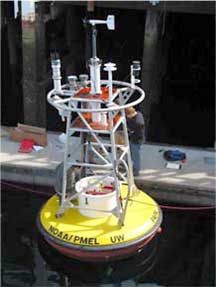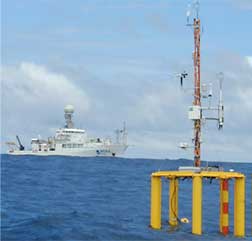Ocean Acidification
Atmospheric carbon dioxide (CO2) and methane concentrations are now higher than they have been for more than 400,000 years, primarily as a result of human use of fossil fuels and land clearing. The global oceans are the largest natural reservoir for this excess carbon dioxide, absorbing approximately onethird of the carbon dioxide added to the atmosphere by human activities each year. The uptake of CO2 increases ocean acidification, which threatens marine organisms, including corals that support oceanic biodiversity. Over the next millennium, the global oceans are expected to absorb approximately 90 percent of the CO2 emitted to the atmosphere. NOAA’s preeminent researchers are rapidly improving our understanding of the carbon cycle thanks to aggressive research in this field.
NOAA Researchers Co-Author Report on Carbon Dioxide Threats to Marine Life

NOAA scientists and technicians make final adjustments on the first buoy to carry equipment that measures ocean acidification. The buoy was launched in the Gulf of Alaska.
A peer-reviewed paper co-authored by NOAA researchers Richard Feely, and Christopher L. Sabine at NOAA's Pacific Marine Environmental Laboratory (PMEL) in Seattle, WA, documents how carbon dioxide from burning fossil fuel dramatically alters ocean chemistry and threatens the health of marine organisms, including corals. The researchers also uncovered new evidence of ocean acidification in the North Pacific. Scientists observed measurable decreases in pH along with an increase in dissolved inorganic carbon, both signs of ocean acidification, which may be the result of the ocean’s uptake of anthropogenic carbon dioxide.
The increased acidity lowers the concentration of carbonate ions, a building block of the calcium carbonate that many marine organisms use to grow their skeletons and create coral reef structures. Corals and some free-floating plants and animals at the bottom of the food chain, have a more difficult time producing their shells, with potential consequences for other sea life that depend on the health and availability of these shelled organisms. The report resulted from a workshop sponsored by NOAA, the National Science Foundation, and the U.S. Geological Survey. Feely and Sabine were among a group of NOAA researchers awarded the Commerce Department’s Gold Medal for pioneering research leading to the discovery of increased acidification in the world's oceans.
NOAA Research and Partners Launch First Buoy to Measure Acidification
The Pacific Marine Environmental Laboratory and partners launched the first buoy to monitor ocean acidification, a result of carbon dioxide absorbed by the ocean. The Gulf of Alaska buoy is a new tool for researchers to examine how ocean circulation and ecosystems interact to determine how much carbon dioxide the North Pacific Ocean absorbs each year. Attached to the 10-foot diameter buoy are sensors to measure key climate indicators in the lower atmosphere and upper ocean.
The buoy is anchored in water nearly 5,000 meters deep and transmits data via satellite. Buoy instruments will measure the air-sea exchange of carbon dioxide, oxygen, and nitrogen gas in addition to the pH, a measure of ocean acidity, of the surface waters. This is the first system specifically designed to monitor for ocean acidification. The buoy is part of a National Science Foundation project awarded to oceanographers at PMEL and the University of Washington in Seattle, Wash., in collaboration with Fisheries and Oceans Canada and the Institute of Ocean Sciences in Sidney, B.C.
PREEMINENT RESEARCH

Deployment of experimental equipment to measure air-sea gas exchange in the Equatorial Pacific. NOAA Photo.
OAR scientists conduct preeminent research to "understand climate variability and change to enhance society's ability to plan and respond" — one of NOAA’s four mission goals. OAR’s Climate Program Office and ocean laboratories improve our understanding of the global carbon cycle, connections to ocean acidification, and the potential impacts on marine life and the planet.
NOAA’s Climate Program Office supports research to improve our ability to predict the fate of human-produced CO2 and how much will end up in the atmosphere in the future using atmospheric and oceanic global observations, process-oriented field studies and modeling. Its priorities are to study the sources of CO2 and its sinks, that is, reservoirs for CO2 outside the atmosphere, such as large forests.
Scientists at NOAA’s PMEL and Atlantic Oceanographic and Meteorological Laboratory (AOML) in Miami, FL, work closely together to support NOAA's Climate Program and Global Carbon Cycle Program. NOAA’s PMEL has three primary observational activities: (1) instruments that collect CO2 information from a variety of ships as they transit the oceans to determine the rate of air sea CO2 exchange; (2) CO2 time series by building a network of CO2 moorings to make high resolution time series measurements in the global ocean; and (3) global inventory to help monitor changes in ocean carbon chemistry by making inorganic carbon measurements throughout the water column on research cruises in the Atlantic, Pacific, and Indian oceans, in coordination with our international partners through the US CLIVAR/ CO2 Repeat Hydrography Program.
The goal of AOML’s CO2 research is to assess the ocean's role in controlling atmospheric carbon dioxide levels with focus on observations of the exchange of CO2 across the air-sea interface and its eventual penetration into the water masses of the deep ocean. AOML projects include measurement of surface CO2 levels in the oceans on NOAA ship RONALD H. BROWN and volunteer observing ships (VOS) in order to determine the exchange of CO2 between the ocean and the atmosphere. The VOS include cargo ships and a cruise ship Explorer of the Seas. AOML also takes water column measurements of the total carbon content of seawater to discern changes over time as part of the CO2/ CLIVAR repeat hydrography project.
NOAA’s Earth System Research Laboratory Physical Sciences Division in Boulder, CO, is working with other NOAA labs to develop a new technique to measure CO2 fluxes over the open ocean. This is an important step in assessing the role of oceanic uptake in the global CO2 budget and the likely effectiveness of controls on usage of fossil fuels and land clearing.
VALUE TO SOCIETY
NOAA’s research will help society better understand the potential impacts of changes in the world’s oceans on sensitive marine organisms and how these impacts may alter important ecosystems. For example, healthy coral reefs are the foundation of many viable fisheries, as well as the source of jobs and businesses related to tourism and recreation. NOAA’s National Marine Fisheries Service estimates the annual value of coral reefs to U.S. fish stocks at over $100 million, and local economies receive billions of dollars from reef tourism. In addition, reef biodiversity is considered key to finding new medicines for the 21st century.
To Learn More, Visit These Sites:
NOAA's PMEL Carbon Dioxide Program: http://www.pmel.noaa.gov/co2/co2-home.html
CO2 Research in AOML: http://www.aoml.noaa.gov/ocd/gcc/co2research/
NOAA’s
Climate Program Office: http://www.climate.noaa.gov/cpo_pa/gcc/
NOAA’s
Earth System Research Laboratory: http://www.esrl.noaa.gov/gmd/ccgg/carbontracker/
To Work or Study at OAR, Visit These Sites:
NOAA Careers: http://www.careers.noaa.gov
Hollings Scholarships:
http://www.orau.gov/noaa/HollingsScholarship/
Knauss Fellowships: http://www.seagrant.noaa.gov/knauss/
June 2007

